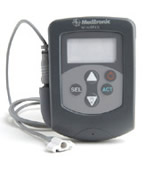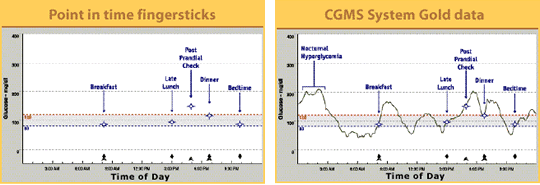In 2006, some 14 years after beginning its CGMS project and a couple of weeks after DexCom received approval for its STS continuous monitor, MiniMed received FDA approval for the sale of its Paradigm REAL-Time System. This system integrates the x22 series of Paradigm pumps with a continuous glucose monitor. The monitor’s accuracy is not good enough to give bolus doses from and it is certainly not accurate enough to “close the loop” which still appears to be several years off. But it does help determine trends in blood sugar levels and can provide early warning for when a blood sugar test may be warranted for a rise or fall in the blood sugar. Significant differences in accuracy can be seen in one individual when two different monitors are worn at the same time.
Sensors are inserted through the skin, usually in the abdomen, using aSens-Serter or by hand, much like an infusion set. A wire with an enzyme reaction monitors glucose changes beneath the skin. Another wire on the surface of the skin connects the 3-day throw-away sensor to a teardrop-shaped radio transmitter. The sensor platform has an adhesive that keeps it in place, while the transmitter must be secured with tape or adhesive nearby. Rather than transmitting glucose information to a separate display as in the Guardian RT system, the glucose trend line and arrows showing the speed at which the blood sugar is changing are displayed on the pump screen. The sensor system provides an average blood sugar measurement every five minutes for up to three days.
The pump displays glucose readings, safety alarms, and 3 and 24-hour trend data that helps you intervene to improve your glucose control and reduce the severity and duration of high and low blood sugars. You can analyze historical glucose patterns by uploading your glucose trend data to a software program called CareLink® Online Therapy Management System (Requires Win98, WinME, WinNT, WinXP, or Win2000 and IE 5.5 or greater). Over time, valuable information can be gained about the effects of particular meals, exercise, and insulin on your glucose levels.
The Paradigm 522 and 722 insulin pumps are available by prescription for purchase in the U.S at a list price of $6,195 for the insulin pump components. An optional starter kit for the continuous glucose monitoring components sells for $999. For insurance purposes, the components are handled separately. Although insurance plans provide coverage for insulin pumps, continuous monitoring is covered by only a few insurance companies and most of the coverage occurs in just a few states.
The Guardian RT
In 1999, MiniMed received FDA approval for it’s CGMS system in June of 1999 for 3-day use in a physician’s office.

Once inserted, information from the transmitter is sent to the monitor shown on the right. While wearing a sensor, buttons can be pushed on the monitor to mark mealtimes, medications, exercise and other events you may want to recall later. These events show up on the CGMS System graphical output, so you can see where your glucose levels were at those times. At the end of the 3-day test period, you return to your healthcare professional with the CGMS sensor and monitor so you can go over the data the system has collected.
Currently, the Guardian RT can only be prescribed by doctors in the following U.S. cities where there is a better chance for insurance coverage:
- Austin, Texas
- Boston, Massachusetts
- Chicago, Illinois
- Houston, Texas
- Minneapolis/St. Paul, Minnesota
- San Antonio, Texas
- Tampa, Florida
The availability of the Guardian RT system was limited to these cities because of the initial price of about $3,500 planned for the system. However, the release of the Dexcom continuous monitoring system for $800 or less may reduce the initial cost for this system. No price has been set as yet for the home version which has FDA approval and is expected to be available sometime in 2007 for those not on an x22 pump.
MiniMed introduced its first insulin pump, the model 502 pump, in 1983. Purchased by Medtronic in 2003 for $3 billion, Minimed’s diabetes products include external insulin pumps, some infusion sets, it’s continuous glucose monitoring technology, and a few other products. Meanwhile, MiniMed’s founder, Al Mann, has started a company called Mannkind with plans to bring to market insulin that is faster than today’s “rapid” insulins.

